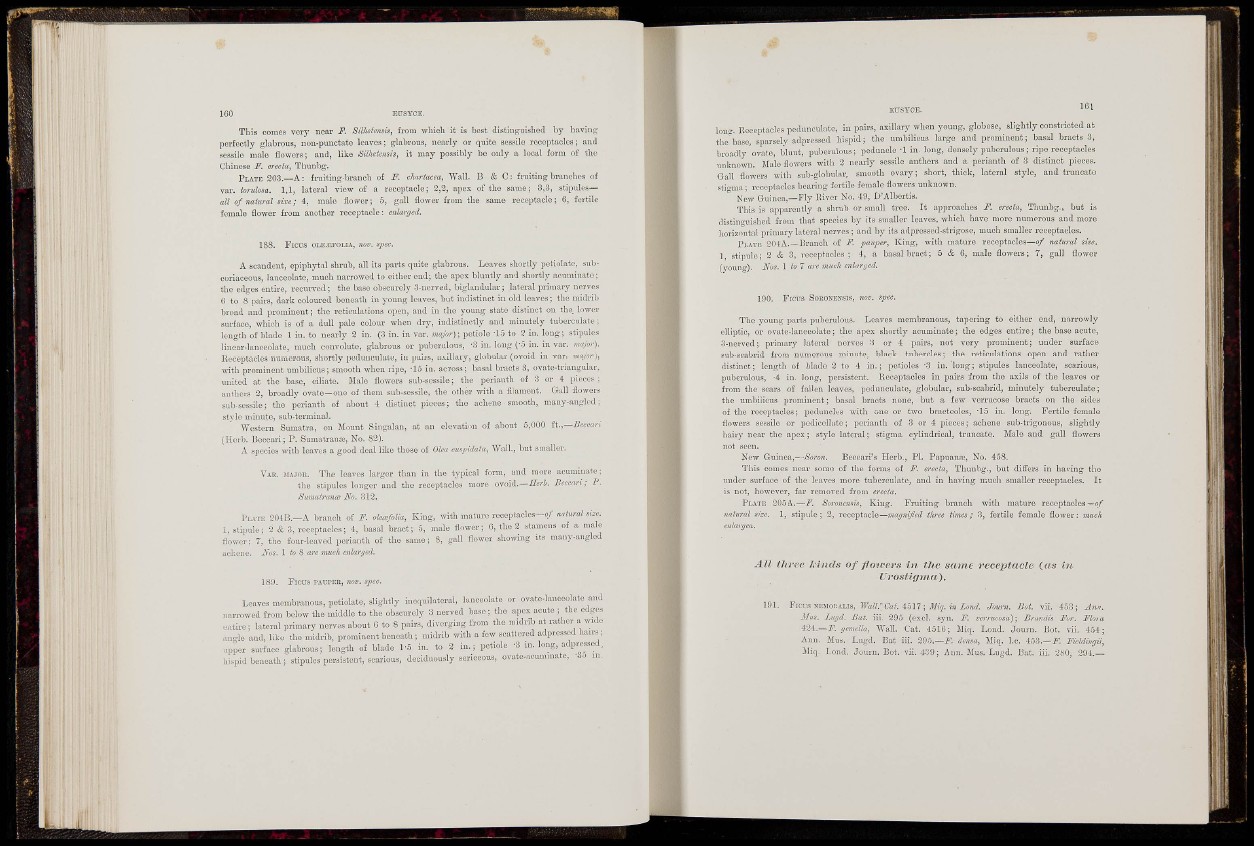
IGO EUSYGE.
This comes vcrj' near F. Silheienm, from which it is best distinguished by baviiiff
perfectly glabrous, nou-pimctate leaves; glabrous, nearly or quite sessile recoptacles; and
sessile male flowers; and, like Silhdensis, it may possibly be only a local form of the
Chinese F. erecta, Thunbg.
P l a t e 203.—A: fruiting-branch of F. chartaeea, Wall. B & C: fruiting branches of
var. torulosa. 1.1, lateral view of a receptacle; 2,2, apex of the same; 3,3, stipules—
all of natural sixe; 4, male flower; 5, gall flower from the same receptacle; 6, fertile
female flower from another rcceptacle: enlarged.
188. Ficus OLEJiFOLiA, tiov. spec.
A scandent, epiphytal sbrub, all its parts quite glabrous. Leaves shortly petiolate, subcoriaceous,
lanceolate, much narrowed to either end; the apex bluntly and shortly acuminate;
the edges entire, recurved; the base obscurely 3-nerved, bigkndular; lateral primary nerves
6 to 8 pairs, dark coloured beneath in young loaves, but indistinct in old leaves; the midrib
broad and prominent; the reticulations open, and in the young state distinct on the. lower
surface, which is of a dull pale colour when dry, indistinctly and minutely tuberculate;
length of blade 1 in. to ncai-ly 2 in. (3 in. in var. major); petiole -15 to ? in. long; stipules
linear-lanceolate, much convolute, glabrous or puberulous, -3 in. long ('5 in. in var. major).
Roceptacles numerous, shortly pedunculate, in pairs, axillary, globular (ovoid in var. major),
-with prominent umbilicus; smooth wlien ripe, -15 in. across; basal bracts 3, ovate-triangular,
united at the base, ciliate. Blale flowers sub-sessile; the perianth of 3 or 4 pieces;
anthers 2, broadly ovate-one of them sub-sessile, the other with a filament. Gall flowers
sub-sessile; the perianth of about 4 distinct pieces; the achene smooth, many-angled;
style Canute, sub-terminal.
Western Sumatra, on Mount Singalan, at an elevation of about 5,000 it.,—Bcccarl
(Herb. Beccari; P. Sumatrance, No. 82).
A species with leaves a good deal like those of Olca cuspidata, Wall., but smaller.
Var, major. The leaves larger than in the typical form, and more acuminate;
tlie stipule.? longer and the receptacles more o v o i d .—B e c c a r i ; P.
SamatruncB No. 312.
P l a t e 204B.—A brancli of F. olecefolm, King, with mature receptacles—o/ natural size.
1, .«tipale; 2 & 3, receptacles; 4, basal bract; 5, male flower; 6, tke 2 stamens of a male
flower; 7, the four-leaved perianth of the same; 8, gall flower showing its many-auglcd
achene. Nos. 1 fo 8 are much enlarged.
189. Ficus paupee, nov. spcc.
Leaves membranous, petiolate. sligktly iuequilateral, lanceolate or ovate-lanceolate an.l
narrowed from below the middle to the obscurely 3 nerved base; the apex acute ; the edges
. a t i r e ; lateral primary neiwes about 6 to 8 pairs, diverging from the midrib at rather a wide
uu<rle and like the midrib, prominent benoatb; midrib with a few scattered adpressed hairs ;
apr>er surface glabrous; length of blade I'O in. to 3 in.; petiole -3 in. long, adpi^_ssed.
hispid beneath; stipules persistent, scarious, deciduously sericeous, ovate-acuminate, in.
lont^. Eoceptacles pedunculate, in pairs, axillary when young, globose, slightly constricted at
the'base, sparsely adpressed hispid; the umbilicus large and prominent; basal bracts 3,
broadly ovate, blunt, puberulous; peduncle -1 in. long, densely puberulous; ripe receptacles
unknown. Male flowers with 2 nearly sessile anthers and a periantb of 3 distinct pieces.
Gall flowers with sub-globular, smooth ovary; short, thick, lateral style, and truncate
stigma; receptacles bearing fertile female flowers unknown.
New Guinea,—Fly River No. 49, D'Albertis.
This is apparently a shrub or small tree. It approaches F. erecta, Thunbg., but is
distinguished from that species by its smaller leaves, which have more numerous and more
lioriznntal primary lateral nerves; and by its adpresscd-strigose, much smaller receptacles.
P l a t e 204A.—Branch of F. pauper, King, with matui-e receptacles—of natural sise.
], stipule; 2 & 3, receptacles ; 4, a basal bract; 6 & 6, male flowers; 7, gall flower
(young), Ifos. I to 7 are much enlanjed.
100. Fictts Sono^JENSis, nov. spec.
The young parts puberulous. Leaves membranous, tapering to either end, narrowly
elliptic, or ovate-lanceolate; the apex shortly acuminate; the edges entire; the base acute,
3-nerved; primary lateral nerves 3 or 4 pairs, not very prominent; under surfacB
sub-scabrid from numerous minute, black tubercles; the reticulations open and rather
distinct; length of blade 2 to <1 in.; petioles -3 in. long; sti^rales lanceolate, scarious,
puberulous, •4 in. long, persistent. Receptacles in pairs from the axils of the leaves or
from the scars of fallen leaves, pedunculate, globular, sub-scabrid, minutely tuberculate;
the umbilicus prominent; basal bracts none, but a few verrucose bracts on the sides
of the roceptacles; peduncles with one or two bracteoles, -15 in. long. Fertile female
flowers sessile or pedicellate; perianth of 3 or 4 pieces; aeheno sub-trigonous, slightly
hairy near the apex; style lateral; stigma cylindrical, truncate. Male and gall flowers
not seen.
New Guinea,—-Soron. Beccari's Herb., PI. Papuanaj, No. 458.
This comes near somo of the forms of F. erecta, Thunbg., but differs in having tho
under surface of the leaves more tuberculate, and in having much smaller receptacles. It
is not, however, far removed from erecta.
P l a t e 205 i i .—F. Soroncmis, King. Fruiting branch with mature reccptacles —of
nattiral size. 1, stipule; 2, r e c e p t a c l e — t h r e e times; 3, fertile female flower: much
enlargen,.
All three lì mis of flowevH in. fite same veeeytacle {as in
TJì'Ostìyma).
191. Ficus nkmokalis, WairCat. <ibn-, Miq. in Lond. Journ. Bot. vii. 453; An».
Mus. Lufjd. Bat. iii. 295 (excl. syn. F. verrucosa)-, Brandis Fur. Floia
424.—P. gemella, Wall. Cat. 451ö; Miq. Lond. Journ. Bot. vii. 4-54;
Ann. Stus. Lugd. Bat iii. 220.—F. densa, Miq. I.e. 453.—Ì. Ficldingii,
Miq. Lond, Jouin. Bot. vii. 439; Ann. Mus. Lugd. Bat. iii. 280, 294.—